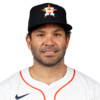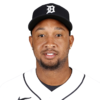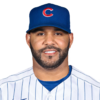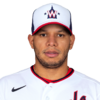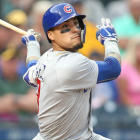Previewing 2019 Fantasy Baseball Rankings: Top 20 second basemen lacking in standouts beyond Jose Altuve, Javier Baez
At a time when position scarcity is supposed to be on the outs, second base is surprisingly short on high-end options. That's what happens after a season when so much went wrong, writes our Scott White.
Hmm.
Not quite how I imagined it looking, this one.
It's not that it's bad per se — I was disappointed to have to cut off the list at 20, actually — but if you're looking for a sure thing, second base isn't the position to find it.
Part of it's because of who no longer qualifies. Jose Ramirez won't be eligible there to begin 2019. Neither will Matt Carpenter nor Jurickson Profar. Even late-season find Adalberto Mondesi is out. All of them have a reasonable chance of regaining second base eligibility at some point, but the fact is you're drafting someone else to fill that spot.
The biggest problem, though, is that not a whole heck of a lot went right at second base in 2018. Mainstays struggled to the point of losing playing time while up-and-comers suffered through prolonged slumps, and there wasn't enough change in the peripherals to explain any of it.
That leaves us with a position that isn't lacking in upside — I have little doubt 12 worthwhile options will emerge before season's end — but nonetheless offers few assurances. It'll be a headache for many in 2019 — one you won't necessarily remedy by investing more in the position since the questions there begin so very early.
... Like at the very top, with Jose Altuve, who's regarded as Fantasy royalty. But he wasn't running neck-and-neck with Mike Trout in 2018 and in fact wasn't running much at all. The batting average is never an issue for him, and the power dip doesn't concern me too much either given that his batted-ball profile was almost identical to 2016 and 2017. But stealing is a choice, and him choosing to do so half as much this year might be a preservation tactic as he approaches his 30th birthday.
Javier Baez gives second base another elite option alongside Altuve after an MVP-level breakthrough, but he's not exactly worry-free. His poor plate discipline makes him all the more dependent on a high BABIP, and while such a BABIP has been the norm for him over the years, it's already about as high as anyone can mathematically sustain, giving him a thin margin for error. Investing a second-round pick in him might be a tad reckless, but it only gets worse from here.
You see? Whit Merrifield is a solid player, but the fact he can rank this high at any position in an era when position scarcity isn't supposed to exist suggests ... well, maybe it does. But hey, his high contact rate and line-drive approach make him a good bet for batting average, and he led the AL in stolen bases for a second straight year. You just shouldn't expect to see him approach 20 homers again, like he did in 2017.
Scooter Gennett more or less validated last year's out-of-nowhere breakthrough, but the power production was down a bit. How much of it was related to the shoulder issue that first flared up in April and was never totally resolved is fair to wonder. Looking at the BABIP, though, my fear is he overachieved a little, and since he doesn't walk much at all, it made for only modest per-game production in points leagues. So he's good, but how good? The jury's still out on that one.
Ozzie Albies' April was so good that it practically guaranteed his final line would be — and it is. But it's like he got worse every month, leading to a ghastly second-half split. Overall, his 2018 was still an impressive accomplishment for a 21-year-old in his first full big-league season, particularly one who stands 5-feet-8 and wasn't certain of ever hitting for power in the big leagues. His low strikeout rate would also suggest he has a high floor. You have to wonder about the ceiling, though, especially since he didn't walk or run like we hoped he would.
I'll take some liberties with my forecast for Gleyber Torres, willing to overpay a little for the upside (which Rafael Devers owners can attest is always the right way to go). After beginning his career with an unsustainable power binge, Torres' numbers settled into something that jibes with his batted-ball tendencies (which are good) and strikeout-to-walk ratio (which isn't), so we can hope for improvement from the 21-year-old without much fear of a setback.
Even if Travis Shaw continues to be only what he was in 2018, that's not bad. It's startable, certainly. Thing is he could be more, as he showed in 2017. He had one of the worst BABIPs in all the sport this year, after all, but then again, it wasn't all luck. He pulled the ball more than ever while also getting shifted on more than ever, and well, it was a bad mix. Overcoming it seems well within his skill set, though.
Maybe in a Rotisserie league or other traditional 5x5 format, you could make the case for Dee Gordon to go as high as fourth, given how scarce steals are. But a lot of good that line of thinking did for you this year. He's one of several second base mainstays who struggled to the point of losing playing time, but it's not like a few missed starts in the second half totally explains why his steals are down. Frankly, I've struggled to explain why any of his numbers are down, so I'm open to the possibility of it being a total fluke. If it's the new normal, though, he's barely mixed league-relevant.
It took some time for Daniel Murphy to find his footing after spending the first 2 1/2 months recovering from microfracture surgery on his knee, but the power still isn't all the way back. And seeing as he'll be 34 next year, we can't assume it ever will be. His low strikeout rate and high line-drive rate still lend themselves to a high batting average, and he's a petty safe bet to find a full-time gig somewhere this offseason. But if he's a diluted version of his already injury-prone self, he's not worth a premium on Draft Day.
I may have DJ LeMahieu too high or too low depending where he winds up, but it's more likely than not he's leaving Colorado, which is a sad thing looking at his splits over the years. The expansive outfield was BABIP magic, giving an all-fields hitter like him an easier time dropping the ball between fielders. He actually departed from that approach a little in 2018, making more of an effort to elevate the ball, which led to the expected tradeoff of batting average for home runs.
Another early-round mainstay who slumped his way into a part-time role, Brian Dozier didn't have the late-season power surge that salvaged his previous two seasons but didn't have much chance for one either. At the deadline, the Twins sent him and his expiring contract to the Dodgers, who already had so many lineup redundancies that you knew he'd wind up on the bench if he didn't perform right away. And that's exactly what happened. While it's true he wasn't striking out more or making measurably weaker contact, he'll be 32 in May and has to convince a team this offseason that he's still worthy of a full-time gig.
Rougned Odor's 2018 was a success in that he convinced the Rangers he's still deserving of a starting job and convinced Fantasy owners he's still an asset on some level. But the production was largely confined to a three-month stretch in the middle of the season. He was abysmal otherwise, and those dramatic ups and downs might just be the norm for a hitter as impatient as he is.
Yeah, Robinson Cano's 2018 was marred by an 80-game PED suspension, but he was basically the same player both before and after it and more or less the same as in 2017 as well. At 36, he's not regaining any power but is a certifiably competent hitter at a position that could use a few more of those. His superior plate discipline makes him a downright sneaky option in points leagues even if his age might keep him from being your first choice.
So it was fairly obvious Jonathan Schoop's 2017 was too good to be true, but his 2018 might be the same level of too bad to be true. He's sort of like Rougned Odor: The poor plate discipline ties so much of his production to his BABIP that you have expect a wide range of outcomes from month to month or even year to year. He'll be back to playing second base every day next year, assuming Mike Moustakas leaves Milwaukee.
One of the players who the Brewers traded for Schoop might end up being the more productive of the two for Fantasy owners now that he's back with a team that lets him run with reckless abandon. I mean, what do the Orioles have to lose? He was a top-five second baseman in all formats after joining them, mostly because he was running so much more, and it wasn't so long ago (2016, in fact) he was the same sort of player over a full season. This ranking is more like a midpoint of possible outcomes than a reflection of most likely scenarios (in other words, he's a high ceiling, low floor player).
There's a lot to like about Jeff McNeil, whose absurd batting average in his first taste of the majors was backed up by a not-so-absurd BABIP. The guy knows how to put the bat on the ball, and while that skill often doesn't measure up in the juiced-ball era (or whatever we're calling it now), I'm not sure he put his best foot forward power-wise. He hit 19 home runs prior to his call-up, after all. I'd be lying, though, if I said there was no chance of the Mets blocking him with Brandon Phillips or someone similar.
Jed Lowrie has been better than the 16th second baseman over the past two seasons, but he's a soon-to-be 35-year-old with no standout skills offensively and a track record that's all over the map. Signing somewhere other than Oakland this offseason might be the best thing for him, judging by his home-away splits, but regardless, he's the sort of player you fall back on if you miss out on the higher-upside options or are looking to back up a shaky one.
The perpetually underrated Cesar Hernandez will be a more properly rated next year after getting a little too homer-happy in 2018. That's what the spike in fly-ball rate suggests to me, anyway. Normally, he's a ground-ball and line-drive guy, which has consistently yielded high BABIPs and batting averages, not to mention better production overall. Still, as long as he continues to bat leadoff for the Phillies, take his walks and pick up his 15-20 steals, he'll be of some use in Fantasy.
It's a Hail Mary at this point — and not a terrible one. Yoan Moncada was arguably the top prospect in baseball heading into 2017, and while his performance in the majors since then hasn't backed up the claim, it's too early to write off the talent. The outrageous strikeout rate doesn't suggest to me he's on the verge of the breakthrough, but the quality of contact when he does make it is high. And as prolific of a base-stealer as he was in the minors, a 30-20 season still seems like a plausible outcome.
Luis Urias didn't get much of a chance to strut his stuff before straining his hamstring in late September, but he'll presumably enter spring training as the favorite for the Padres second base job. He's a curious prospect in that he's regarded more for his pure hitting ability than what he might offer power- or speed-wise, but he generates good exit velocity. And as others like Francisco Lindor, Gleyber Torres and Ozzie Albies have shown, you shouldn't assume the power won't ever come for that sort of player.

